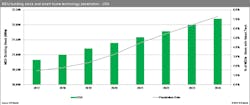IHS: Adoption of smart home tech poised for growth in multi-family dwelling units
Until now, adoption of smart-home technology has been dominated by single-family, detached homes. However, with consumers becoming more educated and smart-home platforms improving their reliability, other sectors now are poised for rapid adoption, such as the multi-family dwelling unit (MDU) market. Despite this growth, penetration of smart-home technology in MDUs is expected to remain negligible during the next five years.
According to the U.S. Census Bureau, about 34% of all occupied housing units in the United States in 2017 were rented. Of these housing units, about 15 million were single-family and 23 million were structures incorporating three or more apartment units.
In terms of U.S. structures with three or more units, IHS Markit estimates that only about 1.5% had one or more smart-home device installed in 2018. In 2024, about 7.3% of MDUs in the United States will have at least one smart-home device installed in their units. This means that about 3.1 million smart-home devices will be shipped into MDUs in the United States in 2024, representing about 1 percent of all smart-home device shipments.
Although the penetration rate of smart-home technology in MDUs appears bleak over the next five years, the future growth opportunity remains robust because the market is still in the evaluation phase, leaving plenty of room for expansion. Property managers presently are still testing smart-home platforms and many properties are in the pilot stage. Similar to the insurance industry’s attempt to deploy smart-home technology, many years of pilot programs, data collection and analysis are required to pave the way for mass-market adoption.
One of the primary motivations for installing smart-home technology in multi-family dwellings is to increase efficiency for property-management teams. For example, smart home systems can combine a view of all of the day-to-day requirements of property managers into a single dashboard. This means combining common-area access control with door locks for each unit, integrating the leasing software and maintenance as well as options for unaccompanied showings. Keeping up with neighboring communities is also a motivation to install smart-home technology. Consequently, a single apartment installing smart-home technology could influence others in the community and create a boom in demand for a neighborhood—or even an entire city. However, many startups now offering MDU platforms with smart technology are focused more on amenities rather than on operational efficiencies.
In order to take full advantage of this nascent market opportunity, platform and service providers should first focus on saving the property manager time and money—and second on smart-home technology hardware.
The market opportunity for smart-home technology is in its infancy. Property managers, owners, investors, service providers, device makers and platform providers are all employing slightly different business models and approaches. There presently aren’t any clear leaders, and although the penetration rates are low today, the growth curve is expected to remain steep for many years.
